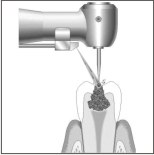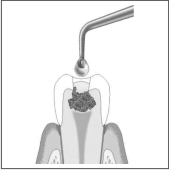INTRODUCTION
Dental caries is an infectious microbial disease resulting in dissolution of organic and disintegration of inorganic substance of the tooth. The damage that caries causes leads to pain, discomfort to the patient, loss of tooth structure and further complications if not treated appropriately and at an optimum time. The dental treatment in itself can be very traumatic and apprehensive for the patient because of use of drills and different types of instruments.
The conventional methods utilized the use of hand excavators and mechanical drills (burs at high and low speed). The small and vibratory stimuli generated by conventional rotating instruments are often painful and, in most cases, there is need for local anaesthesia. About 80% of dental patients are estimated to be apprehensive due to the pain/discomfort experienced due to drills used in caries removal. Also since there is an apparent lack of objective clinical markers, it becomes difficult to establish how much dentine should exactly be removed, and often leads to excessive loss of healthy tooth structure.
Carious dentine can be divided into outer soft, bacteria contaminated caries infected layer which is necrotic, disorganized and non-remineralizable and has to be removed and inner dentine which present little contamination and can be reconstituted by remineralizable and must be preserved. Chemo-mechanical methods remove only outer softened carious
dentine while preserving the underneath healthy dentine and is softer, gentle, and less painful.
INTRODUCTION
Dental caries is an infectious microbial disease resulting in dissolution of organic and disintegration of inorganic substance of the tooth. The damage that caries causes leads to pain, discomfort to the patient, loss of tooth structure and further complications if not treated appropriately and at an optimum time. The dental treatment in itself can be very traumatic and apprehensive for the patient because of use of drills and different types of instruments.
The conventional methods utilized the use of hand excavators and mechanical drills (burs at high and low speed). The small and vibratory stimuli generated by conventional rotating instruments are often painful and, in most cases, there is need for local anaesthesia. About 80% of dental patients are estimated to be apprehensive due to the pain/discomfort experienced due to drills used in caries removal. Also since there is an apparent lack of objective clinical markers, it becomes difficult to establish how much dentine should exactly be removed, and often leads to excessive loss of healthy tooth structure.
Carious dentine can be divided into outer soft, bacteria contaminated caries infected layer which is necrotic, disorganized and non-remineralizable and has to be removed and inner dentine which present little contamination and can be reconstituted by remineralizable and must be preserved. Chemo-mechanical methods remove only outer softened carious
dentine while preserving the underneath healthy dentine and is softer, gentle, and less painful.
CONCEPT OF MINIMALLY INVASIVE DENTISTRY (MID)
MID is contemporary operative treatment that incorporates minimally invasive philosophy in cavity design. Considering that operative intervention is the designated treatment for caries removal and restoration, currently available techniques and contemporary materials necessitate a minimally invasive approach to caries excavation. Minimal intervention applied to the operative field keeps the options open for long term preservation of the restored tooth.2
.
In the current scenario, the focus is mainly on maximum conservation of demineralized, non-cavitated enamel and dentine. Once infection is controlled, caries risk status and evidence of lesion demineralization can be monitored over extended periods.3 Minimal invasive approach to treat dental caries involves mainly detection, diagnosis, interception, and treatment of dental caries on the microscopic level.4 MID for treatment of dental caries include non-surgical conservative modalities and a key concept that dental caries should be treated as infectious disease. The use of chemo-mechanical caries removal system is desired to remove adequate quantities of carious dentine and at the same time preserve healthy dental tissues.5,6
A UNIQUE CARIES REMOVAL SYSTEM (Fig-1)
A new chemo-mechanical method of caries removal based on MID concept.It is a two paste system consisting of gel of high viscosity, containing three amino acids, and a transparent fluid containing 0.5% sodium hypochlorite.
MECHANISM OF ACTION
It is a gel based method for caries excavation which is minimally invasive and offers treatment with minimum pain and better preservation of teeth. It is effective due to its action on only the carious part of the tooth in contrast to conventional method of drilling, which removes both the infected and affected dentin, resulting in excessive loss of healthy tooth structure.
When it comes in contact with caries, it releases chlorine which has detrimental action on the collagen fibrils. This makes the caries soft which can be scraped out. The process is repeated until no carious debris is found when scraped.7
Amino acids effectively interact with the dentine by acting on different protein chains of denatured collagen and by enhancing the effect of sodium hypochlorite on carious dentine. Additionally, the amino acids also neutralize the action of the agent on healthy tissue and prevent degradation of healthy collagen. According to Inaba et al8, since it is made of sodium hypochlorite and is a proteolytic agent, it allows more effective removal of organic components, leading to rupture of hydrogen bonds in the dentinal collagen fibres previously degraded by the demineralization process of caries. Consequently, this rupture softens the tissue and reduces the pressure required for removal by attrition.9
This method does allow for better control when compared to removal by burs which lead to large amounts of dentine removal in blocks, and have a higher possibility of pulp exposure.Chemically, it soften the carious dentin while leaving the healthy dentine unaffected. It can be used in combination with drill in condition when the cavity needs to be opened up, to adjust the periphery of the cavity, whenever there are large
amount of caries or when the risk of affecting healthy tissues or the pulp is minimal. 10
Further, this enables to avoid drilling deep into the cavity, as the instruments are designed to scrap in two or in several directions, which reduces the friction during caries excavation.10
TECHNIQUE OF USING CARISOLV
1 The syringes are held with their openings upwards. Remove the caps, keep the syringes upright and screw them together. Mix the liquids until the liquids are homogenous and apply it to the cavity.
2. Drilling, when the cavity needs to be opened up, for adjustment of cavity periphery and when there are large amounts of caries and the risk to affect healthy tissue is minimal.(fig-2)
 | Fig 2
 |
3. A drop of the gel is removed with an instrument and applied to the carious dentine. (Fig-3)
 | Fig 3
 |
4. Let the chemistry work for at least 30 seconds.
5. Scrape the superficial softened carious dentine with hand instrument. Then continue to work carefully using scraping or rotating movements. The gel is not intended to be used in direct contact with the pulp tissues. (Fig-4)
 | Fig 4
 |
6. Remove the softened carious dentine with the instrument. Avoid flushing or drying the cavity.
7. Gradually add new gel and continue scraping. Repeat the procedure until the gel is no longer cloudy and the surface feels hard.(Fig-5)
 | Fig 5
 |
8. If the cavity feels free from caries, remove the gel and wipe the cavity with the moistened cotton pellet and check it with a sharp probe.(fig-6)
 | Fig 6
 |
9. If the cavity is not free from caries, apply new gel and continue scraping.
10. Adjust the periphery of the cavity with a hand instrument or a drill. Restore the tooth with a suitable filling material.
11. Once the gel is mixed, its effect will begin to decline after about 30 minutes. Any gel that is left over should be destroyed.
SUMMARY
A new chemo-mechanical gel based method for caries treatment which is minimally invasive and offers treatment with considerable pain reduction and better preservation of teeth due to its action on only the carious part of the tooth in contrast to conventional method by drilling, which removes both the infected and unaffected dentin, resulting in excessive loss of healthy tooth structure. Chemically, it soften the carious dentin while leaving the healthy dentine unaffected. So it can be used in combination with drill. Drilling can be used whenever the cavity needs to be open up, to adjust the periphery of the cavity or whenever there are large amount of caries or when the risk of affecting healthy tissues or the pulp is minimal.
ACKNOWLEDGEMENT9.296 "
We are grateful to Dr. Meenakshi Sood, Principal, P.D.M Dental College and Research Institute, Bahadurgarh, Haryana for her continuous guidance and support.
REFERENCES
1. Various methods of caries removal in children: a comparative clinical study. J Indian Soc Pedod Prev Dent. 2007 Apr-Jun;25(2):93-6.
2. Peters MC, McLean ME. Minimally invasive operative care. Contemporary techniques and materials: an overview. J Adhes Dent 2001; 3(1): 17-31.
3. Kakaboura A, Masouras C, Staikov O et al. A comparative clinical study on the carisolv caries removal method. Quintessence Int 2003; 34: 269 71.
4. Tyas MJ, Anusavice KJ, Frencken JE et al. Minimal intervention dentistry: a review. FDI Commission Project 1-97. Int Dent J 2000; 50(1): 1-12.
5. Banerjee A, Kidd EAM : In vitro evaluation of five alternate methods of carious dentine excavation.Caries Res 2000;34:144-150.
6. Chaussain-Miller,Decup F et al: Clinical evaluation of carisolv chemi-mechanical caries removal technique according to site concept.Ciln oral Invest 2003;7:32-37.
7. Beeley JA, Yip HK, Sterenson AL. Chemomechanical caries removal: a review of the technique and latest developments. Br Dent J 2000; 188: 427-430.
8. Inaba D, Duschner N, Jongebloed W et al. The effect of a sodium hypochlorite treatment on demineralized root dentine. Eur J Oral Sci 1995; 103(6): 368-74.
9. Petruzillo MA, McNierney HD. Chemomechanical caries removal system in pediatric dentistry. NY State Dent J 1998; 54(2): 29-32.]
10. Giza S et al.Comparative studies of carious defects filling using the classical method and dental drill, and using the Carisolv chemomechanical method and the YAG:Er CTL-1601 laser. Ann Acad Med Stetin. 2007;53(3):88-99.
11.Ericson D, Bornstein R. Development of a tissue preserving agent for caries removal. In: Tissue Preservation in Caries Treatment. Albrektsson J. Survey: Quintessence; 2001. p.153-166. |